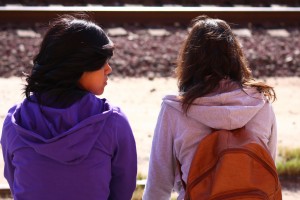An Interview with Aurora Guerrero and Charlene Agabao

Charlene Agabao and Aurora Guerrero talked to Director of Talent Development Josh Welsh about their time at Film Independent, crowd-funding and the process of making their dynamic independent film, Mosquita y Mari. FIND Fellows Aurora Guerrero (Project:Involve 2000) and Charlene Agabao (2009 Producers Lab) are currently prepping their feature Mosquita y Mari, the story of a timid 15-year-old Chicana’s life changes when she develops a complex friendship with the rebellious new girl in her South East Los Angeles neighborhood. The filmmakers plan to shoot in Los Angeles in summer 2011. They have received partial financing from Latino Public Broadcasting and are currently raising the rest of their financing from private sources and through an ambitious Kickstarter campaign. Agabao was in Film Independent’s 2009 Producers Lab with the project. Josh Welsh: How did you two meet and when did you decide to work together on Mosquita y Mari?
CA: Aurora and I met working on Peter Bratt’s La Mission in 2008. She was his Assistant and I was the Art Department Coordinator during production. When production ended, I continued to work on La Mission as an Assistant/Associate Producer to 5 Stick Films. I was asked to read Mosquita y Mari by one of the producers and instantly fell in love with the story. We’ve been working together to make the film happen since then!
JW: Aurora, what was your initial inspiration for making the film? I know the script has been through several drafts along the way – could you talk about that process and how much the story changed from your original conception of it?
AG: Initially, I think it was the complex, same-sex friendships I had growing up. When looking back, long before I identified as queer, I realized my first love was one of my best friends. It was the type of friendship that was really tender and sweet and sexually charged but we never crossed that line. The beginnings of Mosquita y Mari was reflecting back on that time and asking myself the questions, why didn’t we cross that line and what kept us in “our place”? I didn’t grow up in a household where my parents forewarned me that if I turned out to be gay they would disown me. They didn’t wave the Bible in my face saying it was wrong. Instead the message was subtle. It was hidden in the silences around sex and desire; it was implied in society’s expectations, you know, like you only experience those feelings of love and desire with the opposite sex. I think all of us are subject to society’s rules so I think many people can relate to this story of censored friendship. That was the initial inspiration. Originally, the story was placed over a long period of time. The girls meet in elementary school and the film ends when they graduate from high school. It was extremely episodic. Ultimately I was vomiting out a lot of things I needed to address in my own life so the process of re-writing was about me figuring out what I was really trying to get at? What were the central themes? And then it was about me letting go of what didn’t fall into that. You know, because the writing came from such an honest, vulnerable place within me I had a hard time letting go of characters and subplots. That’s really why it took so long for me to rewrite. I had to mourn the losses of some characters that became apart of me and I had to say goodbye. Its more like I had to break it to them, “You’ll live in a script, just not in this one.” It was a crazy-making process, but I kept sane with mentors like Jim McKay, who helped me through the writing process.
JW: Could you talk a bit about your film aesthetic? What’s the visual look you are going for in Mosquita y Mari? Are there specific filmmakers whose work has most inspired you and who somehow inform what you’re doing in Mosquita y Mari?
AG: For Mosquita y Mari I have been inspired by filmmakers of color who, like my film, choose to tell universal stories within specific cultural contexts, like Charles Burnett (Killer of Sheep), Patricia Cardoso (Real Women Have Curves), and So Yong Kim (In Between Days). I mean, artistically, I envision staying true to the authenticity of the script’s voice by refusing to contrive its world or its people. You know, I’m keeping it real. So along with a minimal crew, unobtrusive camera, real locations, and local non-actors, I intend to use a subjective filmmaking style affording audiences an intimate glimpse into the lives of these two young Chicanas at this particular time. I’m also inspired by foreign filmmakers like Warwick Thorton, Carlos Reygadas, and particularly Lucrecia Martel (La Cienega) who I think is a master at creating atmosphere. This is an important element to the look of the film because I’m aiming to transport audiences into this world of unspoken gestures and intimacy through palatable imagery and evocative sounds.












Showing 1 reaction
Sign in with